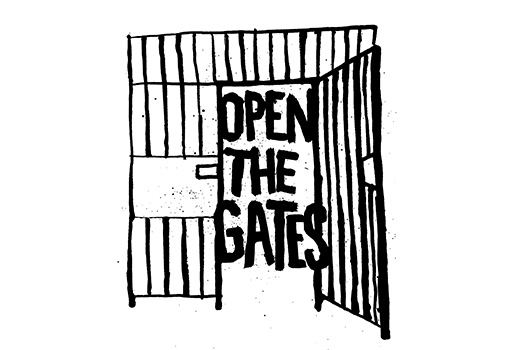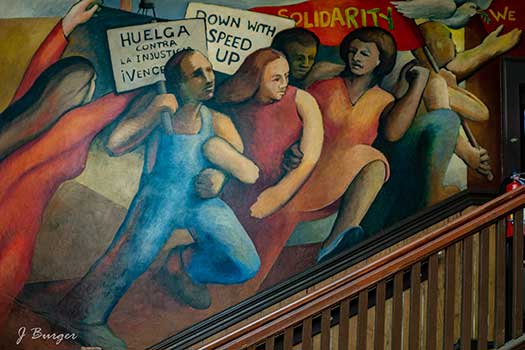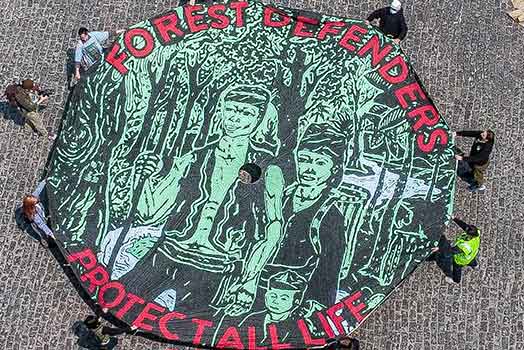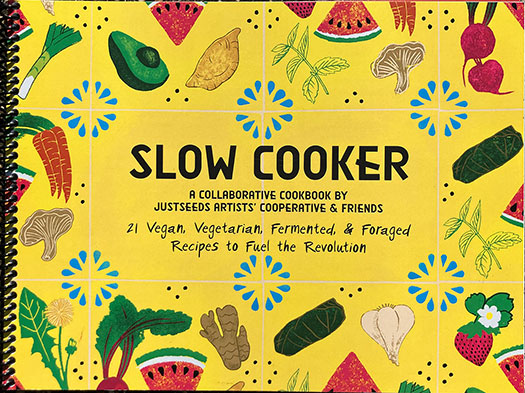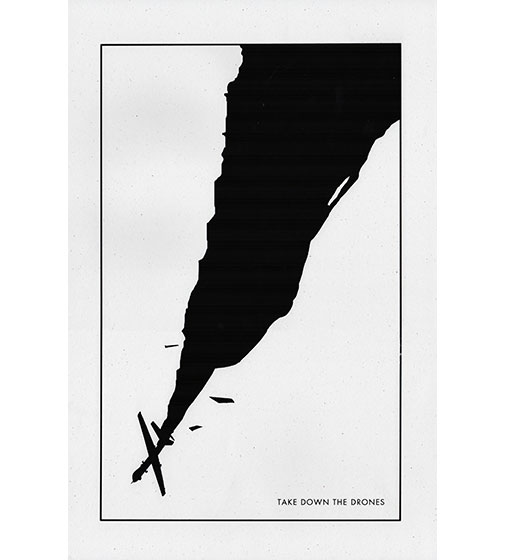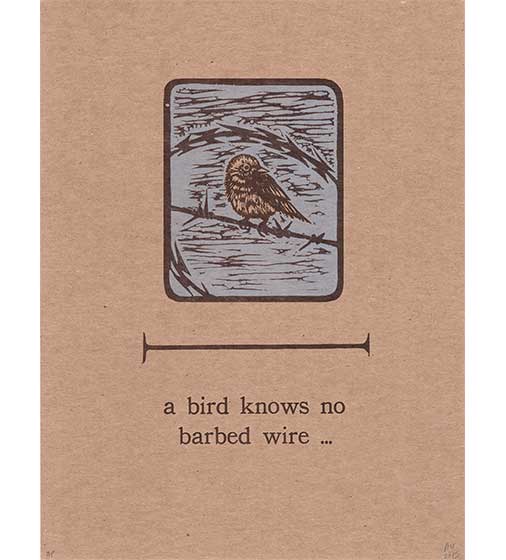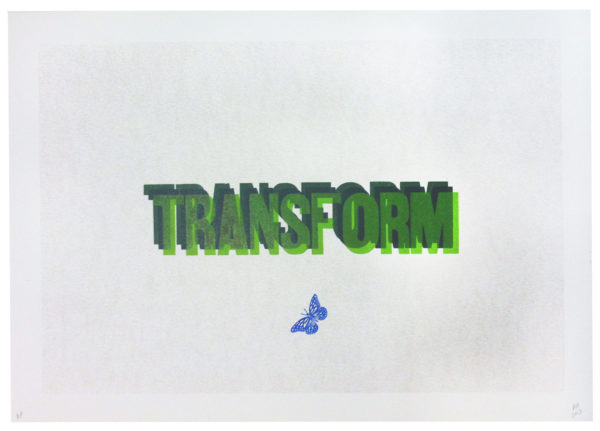An interview with artist Eric J. Garcia about his new book Drawing On Anger: Portraits of U.S Hypocrisy and his celebrated exhibition The Bald Eagle’s Toupee at DePaul Art Museum.

Eric J. Garcia is an admired Chicano artist and Air Force veteran who uses political cartoons as a form of resistance, education, and to call for radical change in the United States. His work can be found in newspapers, blogs, murals, and public spaces from Chicago to Albuquerque.
His new book Drawing On Anger: Portraits of U.S Hypocrisy (available through The Ohio State University Press website) challenges readers to question the contradictions of American society and perhaps get a bit angry.
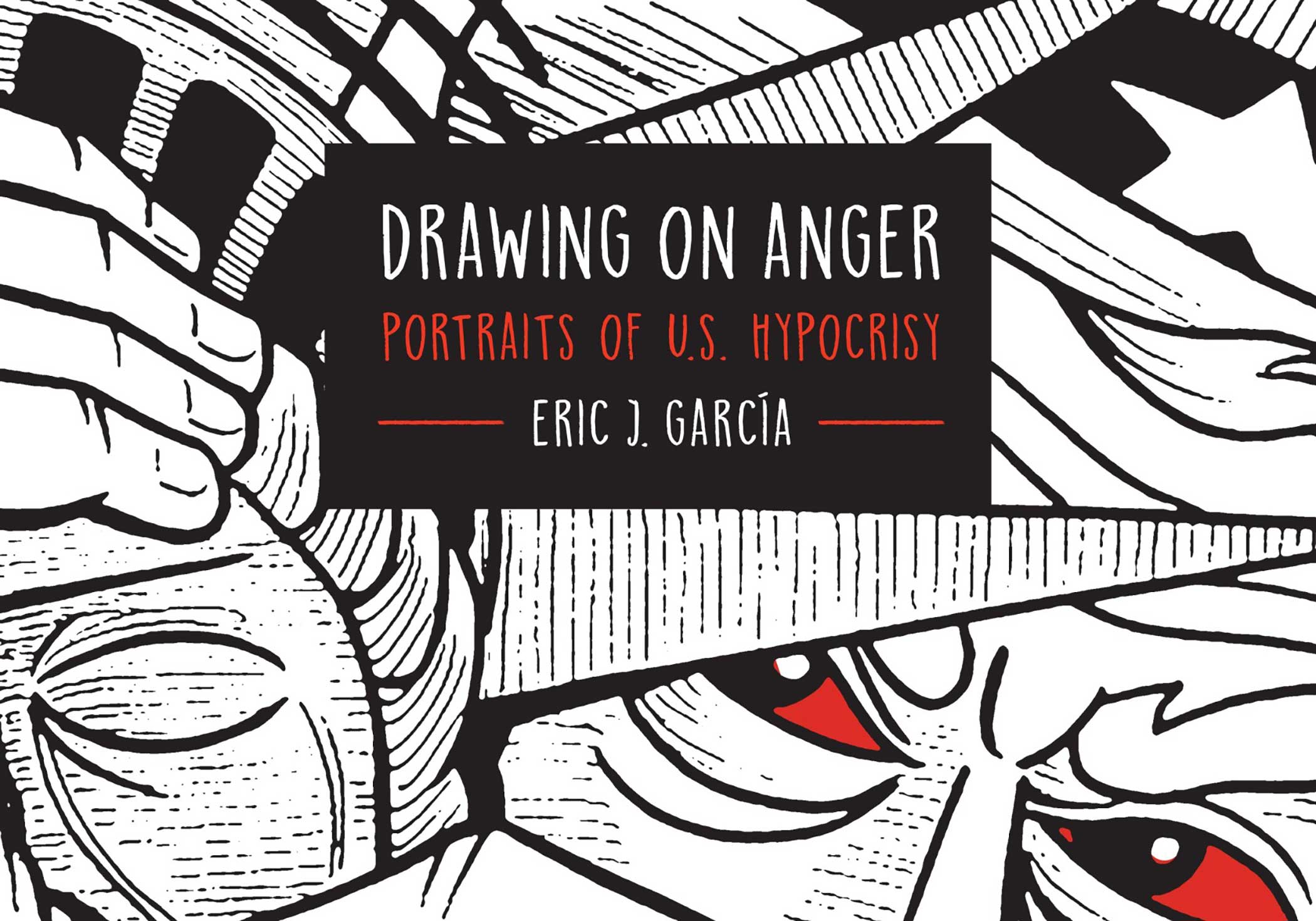
The book features a selection of cartoons from the past fifteen years of Garcia’s non-stop artistic practice of rendering unapologetic political cartoons that provide a humorous but powerful message. It is easy to be drawn into Garcia’s exaggerated seemingly humorous illustrations to only slowly realize the serious reality the drawings depict.
In addition to this new publication, Garcia’s newest exhibition The Bald Eagle’s Toupee at the DePaul Art Museum was awarded the number one spot in the Newcity Art Top 5 for July 2019. It is the only solo exhibition of the six exhibitions included in the first National Veterans Art Museum Triennial. During the correlating Veteran Art Summit Garcia hosted a gallery talk and book signing for community members and fellow veteran artists. Following the gallery talk and book signing I reached out to learn a bit more about his new book, artistic process, and goals for the publication.
What follows is an edited interview between Garcia and myself. Some of the questions were crafted collaboratively with Giselle Mira-Diaz.

Aaron Hughes (AH): What does this phrase, Drawing on Anger, mean to you and how is that reflected in your illustrations?
Eric J. Garcia (EG): The editors from Ohio State Press are the masterminds that came up with the title. It fits perfectly because most of my motivation in creating these cartoons is fueled from frustration and anger about the hypocrisy going on and the desperate need to highlight it.
AH: What do you think is the most important thing you want people to take away from your new book?
EG: People should be really pissed off after reading the book. I hope they take away the harsh reality of the U.S. government. I hope they take away critical perspectives that have been buried and haven’t been given the spotlight they deserve. Ultimately, I hope people start thinking critically and questioning everything.
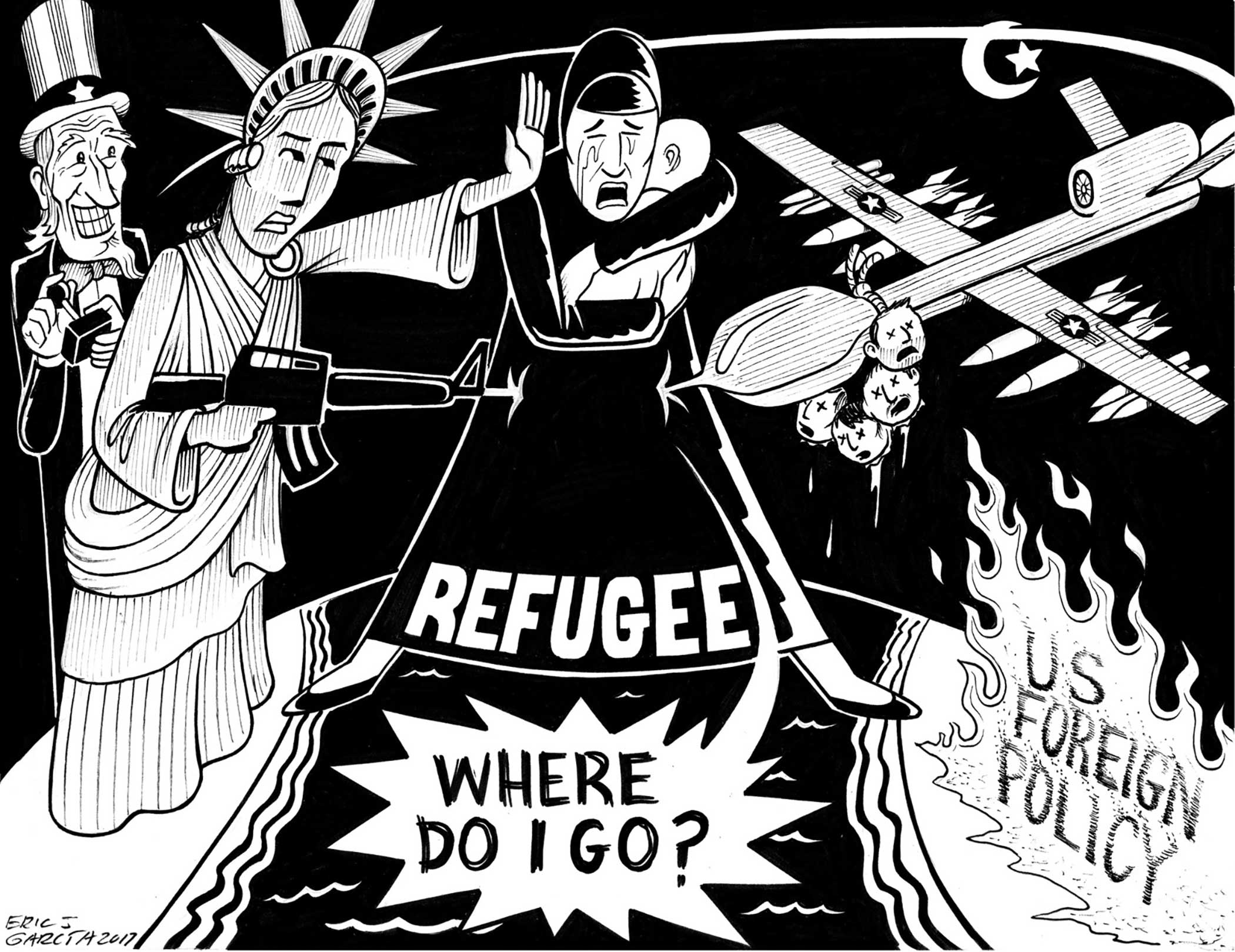
AH: It is such a massive collection. What motivated you to bring so many of your political cartoons into one publication?
EG: I had been told numerous times during the past decade to put all these cartoons into a book. And I had been trying for some time to get it done. Frederick Aldama at The Ohio State University is who was instrumental is getting this book published.
AH: What was the process like, selecting samples of your work from the past decade?
EG: It was a challenge. Trying to pick from all the hundreds of cartoons which ones would go into the book. I decided to narrow it down to the best ten cartoons for each of the twelve past years. My first way of editing them was to sort out the cartoons that were too hyper local. Cartoons that would only register to a regional audience I left out. From there I picked ten cartoons that gave a good overview of that year.
AH: How much of your own story/history is reflected in the publication Drawing on Anger: Portraits of U.S Hypocrisy?
EG: My political cartoons are the portion of my art making that I keep my own personal life out of for the most part. These cartoons are made to highlight others and not myself. Although I’m sure you would be able to gather that I am a Chicano artist because I do a lot of stuff on Latino issues. Or you could easily figure out my own left leaning politics, but only a couple of my twelve years of creating political cartoons feature myself or my story. As for my other artworks my own story is definitely there.
AH: Since your political cartoons do not dive into your personal experience. What is an example of an artwork that you do consider a part of your story?
EG: Miracle at the Cottonwood (Acrylic on tin. 6’x4’ 2011) is a good example. Ex-voto’s are a Mexican folk art, traditionally painted on sheet metal. Normally they depict a miracle that has happened, so they are made in honor and to give thanks to the saint that assisted with the miracle. Usually ex-votos are small intimate pieces, but I created an oversized allegory that gives thanks to San Antonio.
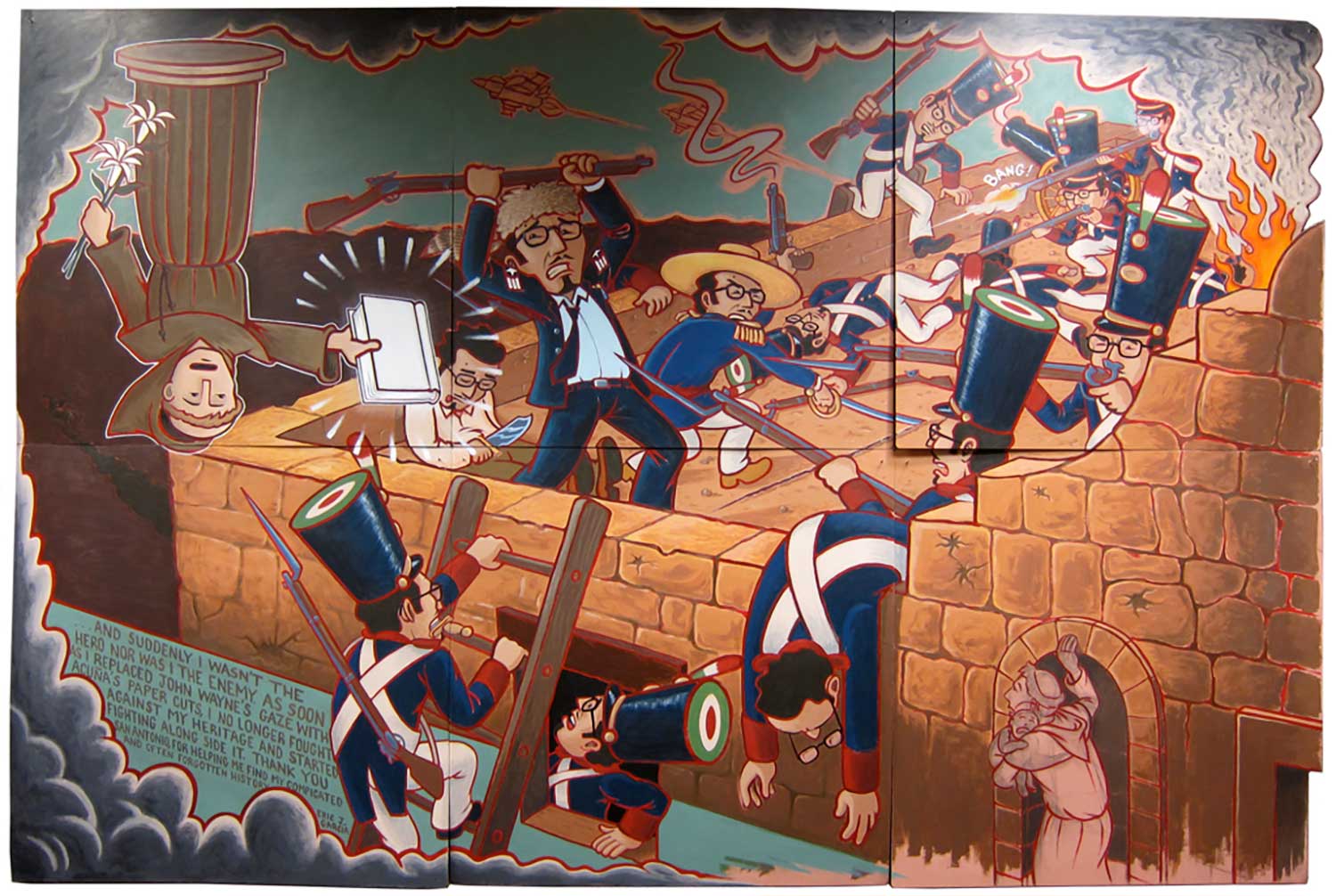
“Historical” TV shows and movies easily influence people who are not familiar with actual history. As a youth I was lost and confused about my history and ethnicity. I grew up watching movies of the famous battle of the Alamo. Using my mom’s sofa as a fort, I recreated battle scenes in which I played the defenders of the Alamo, the “good guys” battling the Mexicans who were the “bad guys.” This painting is in honor of Saint Anthony, (the patron saint of lost things) for helping me find and understand my history. Coincidentally, later I would serve in the United States Air Force where I was stationed in San Antonio and trained in defending U.S. military bases.
AH: You seem to be always creating timely work. What is your creative process like? How do you use this visual medium as a platform to inform, educate and disrupt people’s perceptions?
EG: Visuals are powerful and influential. But they only work if there is an audience to see them. This is why I work in an assortment of media and venues: Murals in streets; “Fine art” in the gallery space; Printmaking which operates between fine art and grassroots activism; Political cartoons which normally live in but are not confined to news media. I am involved with all of these different arenas of production as a strategy to get the art and ideas ingested and digested.

AH: I completely relate to this idea of working with multiple strategies to get the message out to different audiences. With that in mind, can you say a bit more about what you mean when you say, “Printmaking, which operates between fine art and grassroots activism.”
EG: Printmaking is the process of transferring image and text onto another surface. This process is often repeatable allowing for the production of multiple copies. Before there was kinkos copies, there was the craft of printmaking to produce duplicates, which also has a long legacy of being used as a tool for activism due to the importance of getting messages out to a broader audience. But it is also a highly skilled craft and considered a fine art. A fine art medium that clashes with the fine art world’s notion of the precious one-of-a-kind object. Printmaking makes this fine art more accessible to people, it is one of the most democratic of all media. It is made for more than one person which means it can be in multiple places at the same time to influence a great number of people, versus a single object that can only be viewed in one location by a certain amount of people. The print is often cost effective to create, it is inexpensive to buy, and easily transportable. All of these reasons are why it has become a tool for activists to use to spread their messages.
AH: Do you see your cartoons and illustrations playing a specific role as a language of resistance today?
EG: Political cartoons are especially useful in this day-and-age where attention spans are very short and people often don’t want to read long form, in-depth articles. The political cartoon is a condensed complex visual that is eye catching and can be read very easily. I try to use as little wording as possible so the visual does the heavy lifting of telling the story. With the help of iconic imagery and characters like the Statue of Liberty and Uncle Sam, most of my cartoons can be read without knowing english. Putting these cartoons in newspapers, on the web, or projected onto buildings, puts these images out into the public for people to react to. I see my cartoons as counter-propaganda, a reaction to the mainstream media we are bombarded by.

AH: You mentioned Uncle Sam. You use the Uncle Sam character a good deal in your work. For example he appears multiple times in your current exhibition The Bald Eagle’s Toupee at DePaul Art Museum. What are you saying in the exhibition?
EG: Uncle Sam is the United States government personified. In The Bald Eagle’s Toupee I painted Uncle Sam’s head barely peeking out so you only see his sinister eyes watching you as you walk into the first gallery with floor to ceiling murals. His giant arms stretching out to envelop you as you enter into the space. You don’t realize it until you turn around, but you’ve just walked into the bloody clutches of the most dangerous government in the world. And when you go into the connecting gallery, again you see Uncle Sam but this time he is in motion. The animations (that were created by my friend Luis Mayorga) projected on the back wall portray the worst of what the United States has to offer, such as Uncle Sam waterboarding an individual. So in this exhibit Uncle Sam is not shown to be the good guy and the overarching theme of this installation is a very critical look at our nation and all it claims to be.
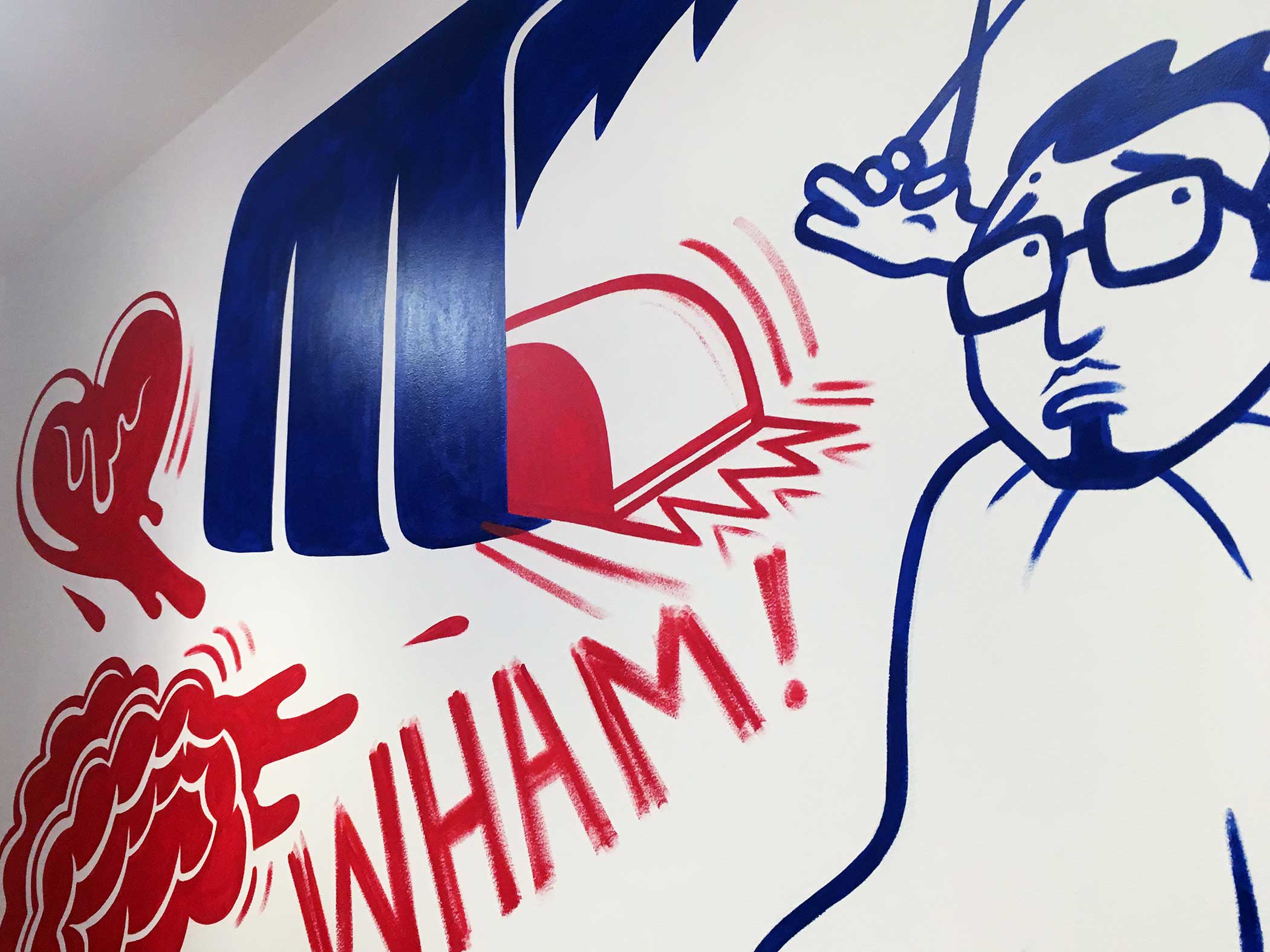
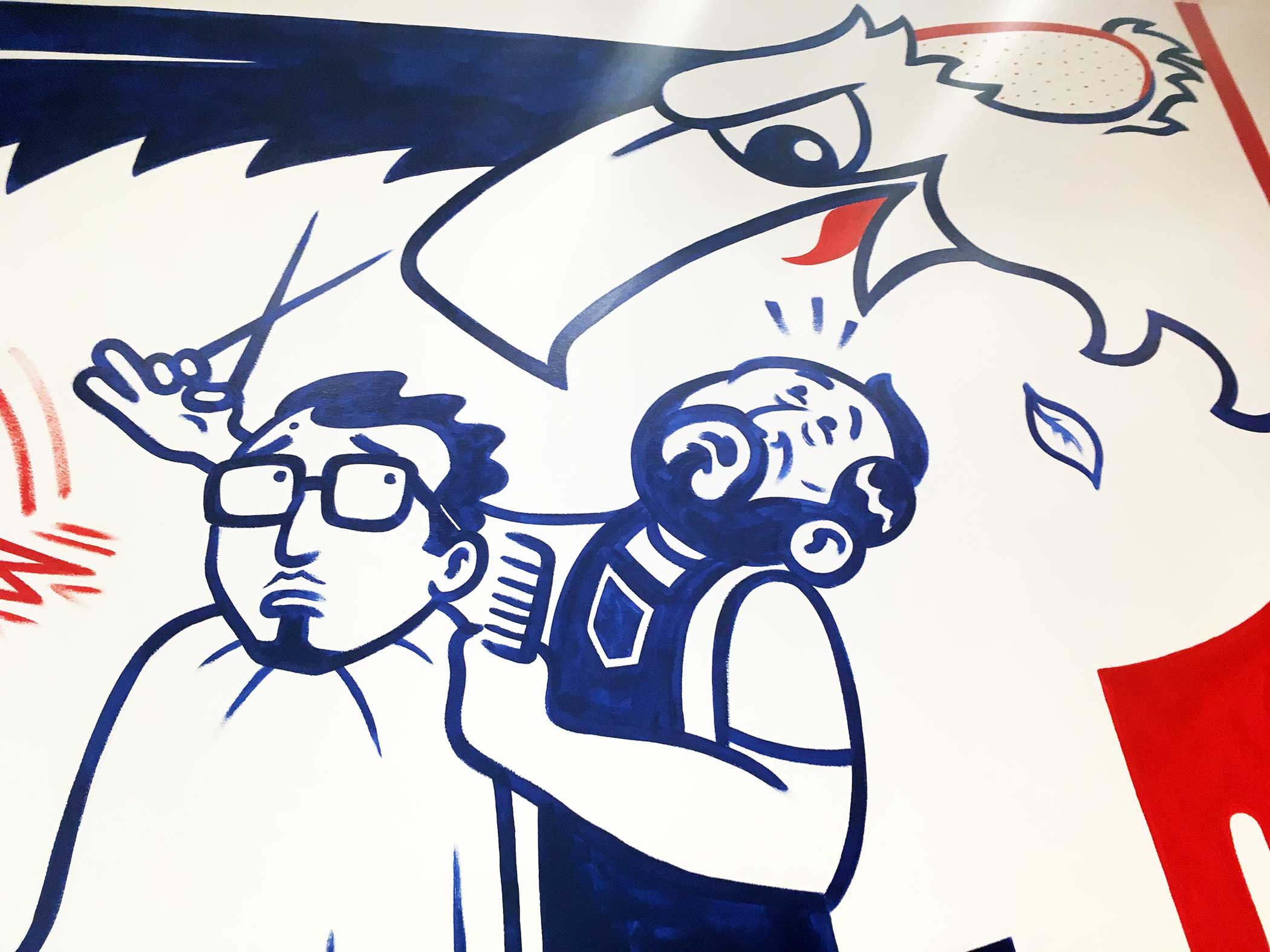
AH: The exhibition is stimulating and hard hitting with the floor to ceiling murals and two channel projection. What work do you feel most excited about? What is it doing?
EG: To have my drawings come to life in the animations was amazing to me. When I was small, I wanted to be an animator and create cartoons. Nowadays I’m used to my drawings as stagnant images, so to see Luis bring them to life was thrilling. It’s one thing to insinuate that Trump has a rodent on his head, but it’s something else to actually see that rodent squirming around on his orange head.
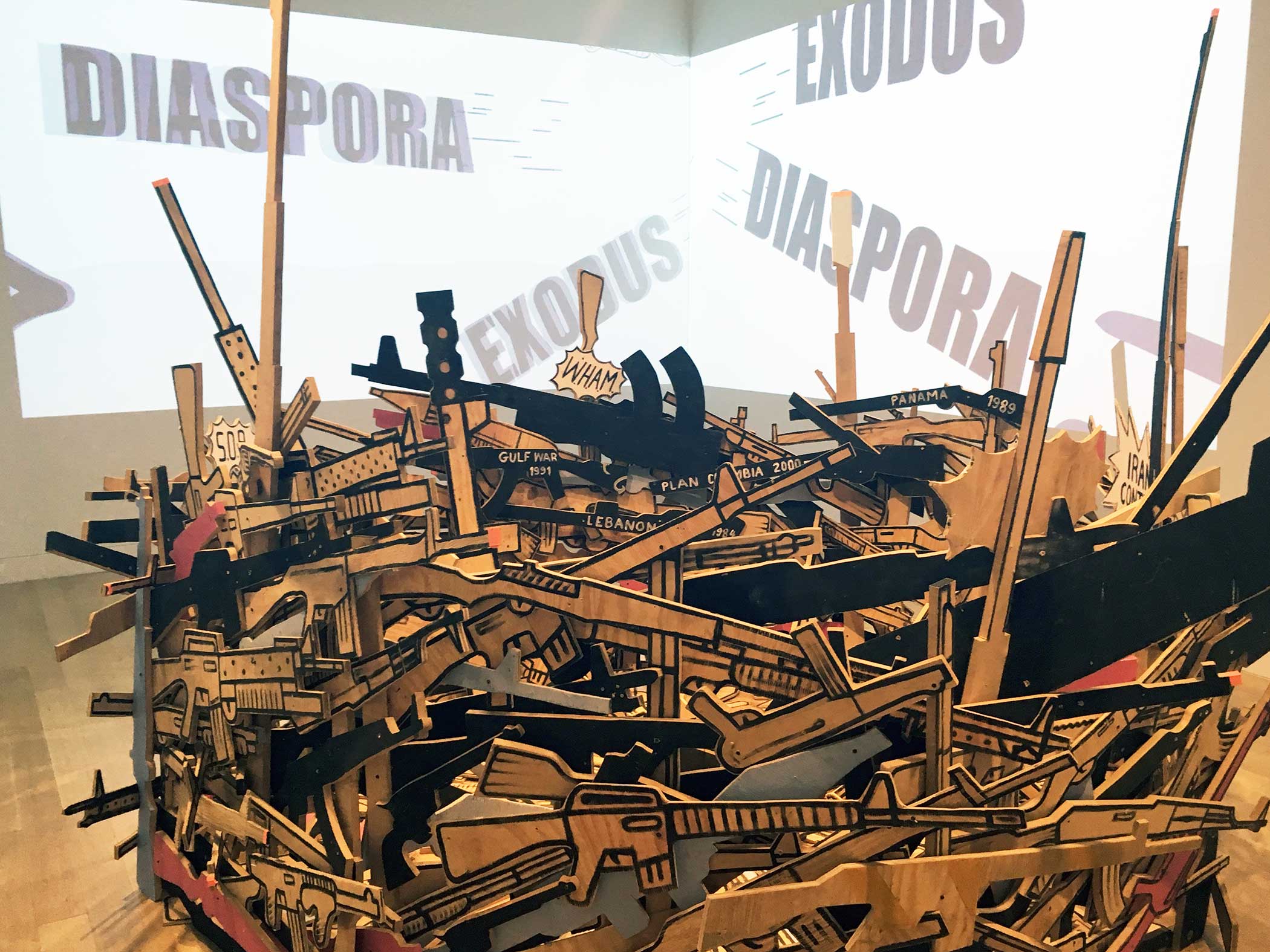
AH: Another work in the exhibition is a video game called Discharged. Can you describe this project a bit and your intentions with it?
EG: This is a collaborative project with the amazing socially conscious video game designers, The Plug-In Studio, who are the originators of the game, came to me to ask if I would be a veteran consultant and help with the visuals for the game. The game was in response to the many popular first-person shooter video games. Some of which have been funded by the U.S. military as recruiting tools pointed at youth, to glorify and make militarism fun. Our game is counter to that and poses a question that these other games never allude to, which is: what happens after the battle and these veterans come home? Our game portrays exactly that, a veteran just off the plane from a deployment and trying to navigate the civilian world with alcoholism, homelessness, and the street-warfare that plagues our inner cities.
AH: What role does humor play in your illustrations reflecting the reality of the U.S. government and our society?
EG: I often equate my cartoons to taking a bitter pill with some honey on it. Funny drawings are the honey that is poured on top of the very disgusting issue. The strategy being: you are pulled in by the humorous drawing, you stay to figure out what is happening and then you realize that this cartoon is not so funny.
AH: A spoonful of sugar helps the medicine go down … Are you ever concerned that people will reject your message outright?
EG: That is a given. But those are the people that need to see these images and need to understand this information. These cartoons and ideas need to be in their face. One of the biggest problems is that this kind of critical thinking was never given to them in schools. So these stories that I’m telling can be shocking to people who have been raised with a rose-colored version of U.S. history. Citizens of the U.S. need to open up their eyes to these point of views and need to refocus so they can see what really is going on.
AH: How do you see your work fitting into the larger history of Mexican-American, Chicano, and Latinx art and political movements?
EG: I’m following in the steps of the Chicano movement’s manifesto “Plan Espiritual de Aztlan” which called for using every means necessary for radical change which included the arts. This was and still is a strategy used by many different political and social movements.
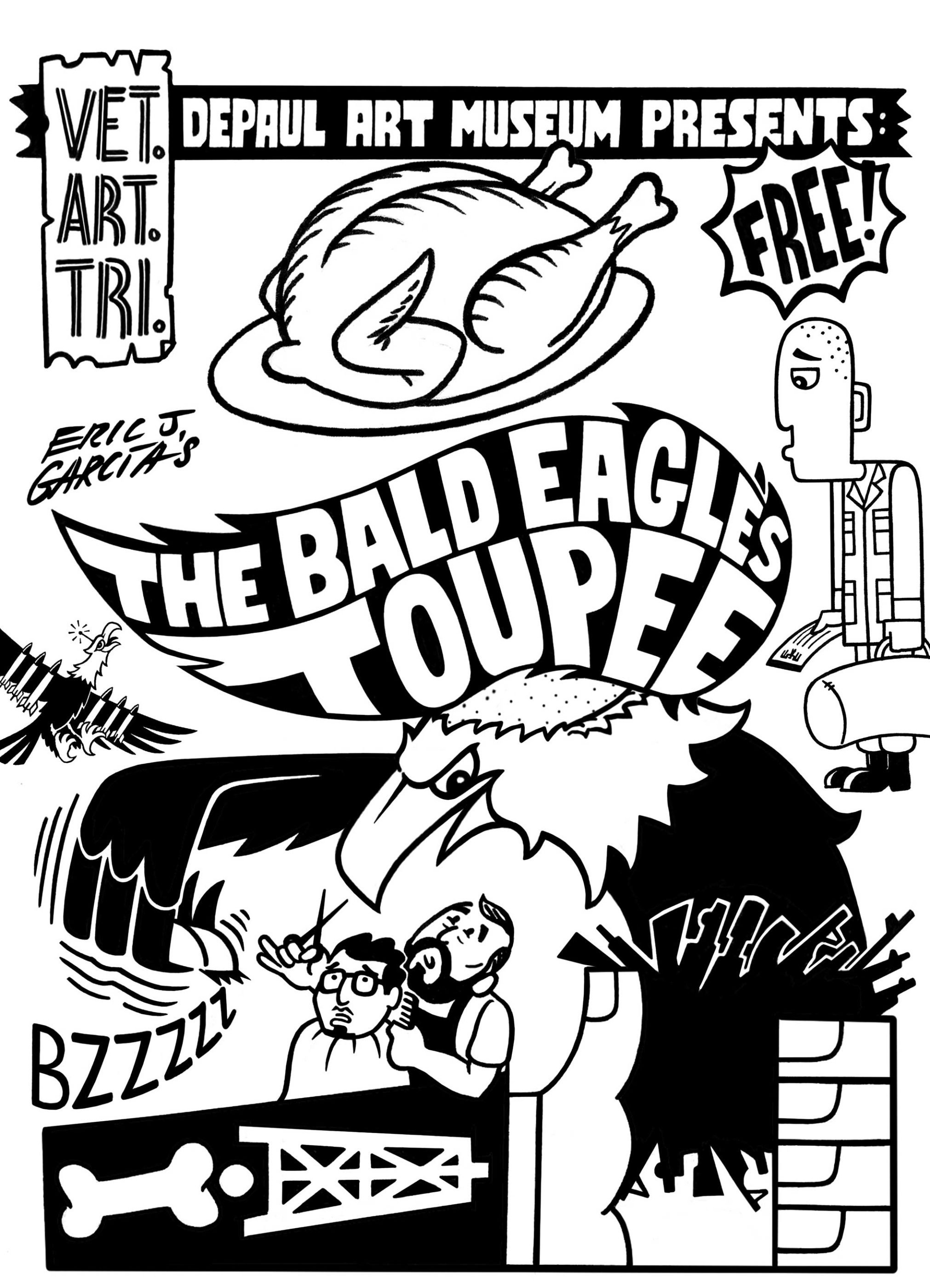
AH: With the exhibition being a part of the first National Veterans Art Museum Triennial, what added meaning does the featured artwork and the exhibition have for you?
EG: Having this exhibition at DePaul Art Museum in conjunction with the Triennial was an honor. It is humbling to be recognized amongst all the great artists who happen to be veterans. So many talented artists came out from across the nation to be a part of the Veteran Art Summit. It was a historical event that you and many others put together. I was super grateful to be a part of it.
AH: Do you see that connect to any specific veteran artists or movements?
EG: I don’t think this is too presumptive, but I think most veteran artists have an activist slant to their work. So in the emerging Veteran Art Movement alone, there is a huge range of creative activism going on. So many different activist/artists working in writing, clay, performance, photography, papermaking, and much more; they are all using any means/media necessary to get out the word about what is going on with this country.
AH: How do you navigate these two somewhat contradictory identities? It seems like in some ways you embody some of the contradictions you bring light to in your cartoons. Are you at times implicating yourself in your drawings?
EG: Of course. I am the conquered and the conquerer. I am the colonized and the colonizer. I was a part of and benefited from the military industrial complex that I now critique. This is the harsh and complex reality of the United States. As a citizen who lives and participates in this greed-based capitalistic society, who pays taxes that fund horrendous atrocities around the world, we are all complicit. Unless I live in a cave and totally unplug I can’t avoid participating. Because I recognize and acknowledge this, that guilt makes me obligated to use my talents to speak truth to the hypocrisy of this country and hopefully inspire others to do the same.
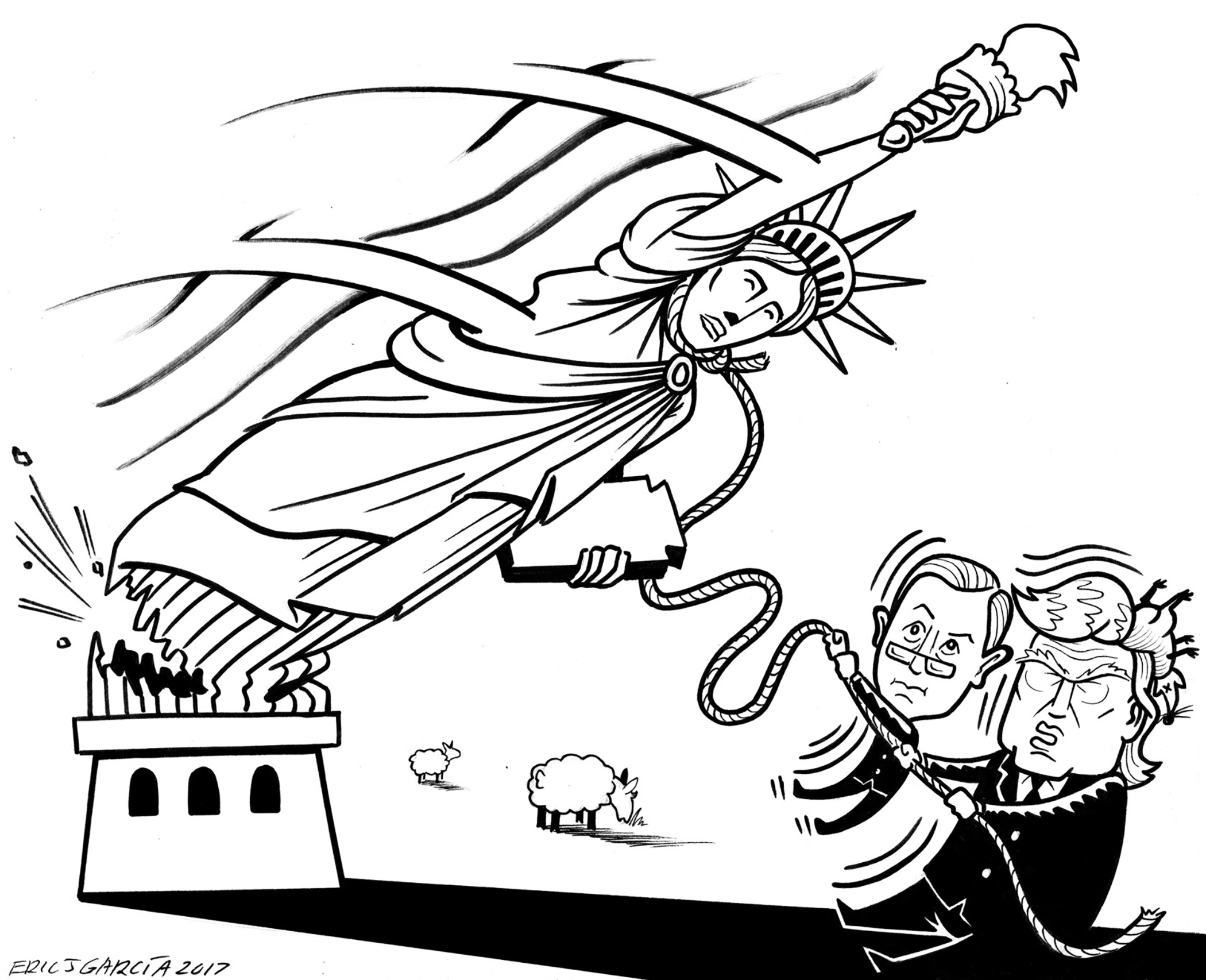
AH: Political cartoons have a history of being easily accessible to radicals and conservatives alike. How does your work connect to people that don’t agree with your critiques?
EG: Again the strength of the cartoon is that it can be read very easily by all. And I want “all” to read them. I want the ill-informed to learn something new. I want allies to use them to teach others. I want opponents to be shamed and exposed. My cartoons are tools to teach, vehicles to carry information, and weapons to strike opponents.
AH: What are your hopes for the Drawing On Anger: Portraits of U.S Hypocrisy publication? How do you see this being circulated?
EG: My hope is that these cartoons reach a broader audience. That libraries and teachers use these cartoons to understand what is going on around us.
AH: What advice do you have for aspiring political cartoonists and artists?
EG: To Future political cartoonists: There’s no money in it, so do it because you truly believe in it.
This interview was done by Aaron Hughes with support from Giselle Mira-Diaz. The interview was crossposted on justseeds.org and veteran-art-movement.net
Drawing On Anger Portraits of U.S Hypocrisy is available on The Ohio State University Press. More info: https://ohiostatepress.org/books/titles/9780814254905.html
Eric J. Garcia: The Bald Eagle’s Toupee was at DePaul Art Museum from April 25, 2019 through August 11, 2019. More info: https://resources.depaul.edu/art-museum/exhibitions/Pages/eric-garcia-eagles.aspx
Eric J. Garcia was born in Albuquerque, New Mexico in 1977. After four and a half years of service in the United States Air Force (1997–2002) he went on to study art and received a BFA from the University of New Mexico and an MFA from the School of the Art Institute of Chicago. Known for mixing history with contemporary politics, Garcia always tries to create art that is much more than just aesthetics. He has exhibited nationally to include such institutions like San Francisco’s Museum of Modern Art, Museum of Latin American Art, and the Museum of Contemporary Art Detroit. More info: https://www.ericjgarcia.com/
